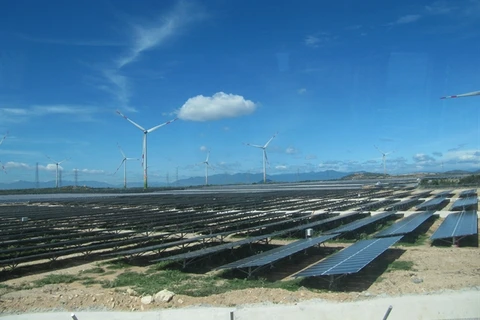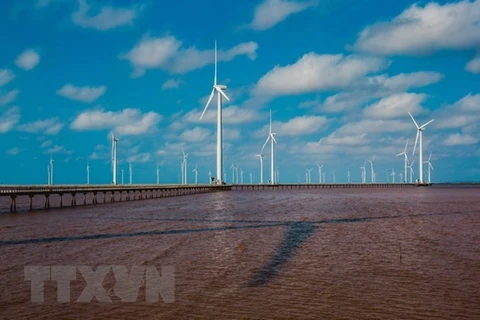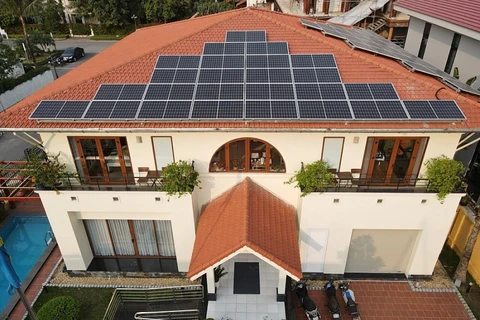Hanoi (VNA) - Vietnam has shown the world its capability to accelerate clean energy solutions, with the highest installed capacity of solar power in Southeast Asia and the government’s commitment to boosting energy supply and strong public demand for improved air quality, according to the Malaysia-based Techwire Asia news website.
In an article published on August 19, Techwire Asia said Vietnam recognises that the transition to green energy has never been more urgent.
As one of the fastest-growing economies in Southeast Asia, the country has demonstrated its seriousness in pursuing the green energy transition, especially when it comes to embracing solar power.
The article cited a World Bank’s report as saying that said Vietnam now boasts the highest installed capacity of solar power in Southeast Asia,16,500MW at the end of 2020.
Separate statistics by the International Renewable Energy Agency (IRENA) showed that Vietnam, at the end of 2020, was within the top 10 countries in the world with the highest installed capacity of solar energy.
The article said with the country’s high solar PV potential and its ambitious green energy goals by 2050 put into consideration, Vietnam has all the means to become a regional and global leader in renewables.
Regarding wind power, Vietnam has one of the best resources in Southeast Asia, with an estimated potential of 311 GWs.
Market experts reckoned if Vietnam retains its lightning pace of renewable energy expansion from the last two years, it will further climb the ranking, potentially surpassing countries like Australia and Italy in renewable energy development and innovative energy solutions, according to the article.
The IEA said Vietnam is the second-largest electricity consumer in Southeast Asia. This is one of the regions that have the fastest growing energy demand in the world, and over the past 20 years the demand has grown at a steady rate of 6 percent. The four largest electricity consumers in the region are Indonesia, Vietnam, Thailand and Malaysia, accounting for more than 80 percent of the total demand in the region.
It was of the view that the Vietnamese Government's commitment to boosting energy supply and strong public demand for improved air quality has been important underlying drivers in this direction. Well-designed and executed supporting regulations and policies such as feed-in-tariffs (FiT), tax incentives, and waiver of land lease are also considered the underlying factors driving renewable energy growth, especially solar, in the country.
Experts believe that Vietnam will attract renewable energy investors in the future thanks to its green energy potential.
Sharing the same comment with Techwire Asia, Eurasia Review said Vietnam recognizes that the transition to green energy has never been more urgent. As one of the fastest-growing economies in Southeast Asia, Vietnam’s march to industrialisation has left a huge carbon footprint and taken a toll on its environment.
“Change was indeed in the air,” Eurasia Review said, adding that it was felt in the more than nine wind power projects, including the Tuy Phong wind farm in the central province of Binh Thuan, one of the first to be established in 2012. Developed by Renewable Energy Vietnam (REVN), a private company, the farm offers 20 turbines with a total of 30 MW installed capacity.
There are other wind farms, like the Phu Quy Wind Farm on Phu Quy Island, about 75 kilometers off mainland Binh Thuan province, it said.
Along with wind farms, there are also domestic solar companies like Solar BK, located in Ho Chi Minh City, initially contracted in 2012 to install solar PV and wind-power generation on the Truong Sa (Spratly) Islands.
Solar power developers are no longer linked exclusively with the Electricity of Vietnam (EVN) and can build rooftop solar arrays in industrial parks and sell power directly to manufacturers or to the EVN.
The global consultancy company McKinsey said while Vietnam’s current energy plan is ambitious, it can become better. It concluded that a renewables-led pathway can unlock a plethora of opportunities for the country, including saving 10 percent of overall power costs, cutting down 1.1 GTs of greenhouse gas emissions, and others./.
























